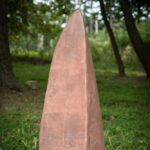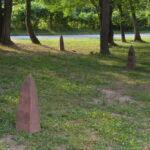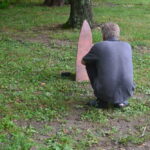How the Soil Remembers Plantation Slavery

This is the third piece in a series on the Plantationocene—an alternate name for the epoch often called the Anthropocene. The Plantationocene Series aims to create a conversation about multiple forms of plantations, both past and present, as well as the ways that plantation logics organize modern economies, environments, and social relations.
Hauntings
There’s something eerie about the fallow fields and subdivisions of Sandy Spring, a town of 6,000 residents just north of Washington, DC, in Montgomery County, Maryland.
Driving around the town, doing research for a site-specific piece to be installed on the grounds of the Sandy Spring Museum as part of the exhibit Land Use, Abuse, and (Re)Use, my collaborator and I found ourselves at Woodlawn Manor—an old plantation that Montgomery County has turned into a park. The grounds hold a large house (often rented out for weddings), a stone barn, an equestrian center, a few historical plaques, and a commemorative Underground Railroad “experience” trail.

“Woodlawn Manor” Google image search results reveal a cultural amnesia that ignores slavery’s legacies. Image by Raina Martens, 2017.
Walking around, we were both struck by the way slavery was remembered in the space. It barely got a paragraph on the main plaque, which proclaims that the farm was the “envy of Montgomery County farmers and the pride of its owners” before noting that “the farm still saw its share of struggles. Enslaved laborers toiled in the fields, within reach of the Underground Railroad.” Slavery was framed as an unfortunate afterthought, while the Underground Railroad trail—the linear path to freedom and the heroism of white Quakers—were emphasized.
This narrative struck us as a violent mis-remembering, a type of amnesia that refused to acknowledge the actual history and impact of enslavement beyond its being a “struggle,” all while emphasizing the forward progressing “path to freedom.”1
Quickly, the eeriness of the landscape made sense— its suburban pastoral appearance was marked by the violence of the past, haunted. That’s what happens when the past gets half-buried.
In Sandy Spring, and the rest of the United States as well, the challenge is not just to accurately remember the violent history of enslavement, but also to reckon with the fact that racialized violence and expropriation persist in the present.
As Viviane Saleh-Hanna observes,
anti-Black police violence today is ghosted by its historic antecedents, was forward-haunted by lynching and the countless deaths inflicted by armed White men on plantations colonizing the vast majority of the Western Hemisphere, overshadowing but unable to fully erase the fact that chattel slavery extends well beyond the Confederate States of the Southern United States and pollutes the Northern regions of the United States, Canada, Western Europe . . . and vast lands and islands south of the United States. Chattel slavery was the underpinning institution for White modernity.
The plantation and slave system is not a sad aberration, best forgotten, in the forward-marching progression of history, as it is often characterized in popular white discourse. It is, as suggested by the Plantationocene, the very basis of modernity itself. As Donna Haraway notes, “scholars have long understood that the slave plantation system was the model and motor for the carbon-greedy machine-based factory system that is often cited as an inflection point for the Anthropocene.”
Thinking with theorist Fred Moten’s assertion that “[enslavement] is better, if still inadequately, understood as durational field rather than event,” we understand the present to be the plantation system’s afterlife.
It is in this durational field, that of the Plantationocene, that we found ourselves, looking to the fallow fields around the Sandy Spring Museum, in an attempt to get to know what exactly haunts the landscape.

Fallow fields beside the Sandy Spring Museum allude to the area’s agricultural past. Image by Raina Martens, 2017.
Fieldwork / Core Sample
The Sandy Spring Museum, set between fields and large, widely-spaced homes, just two miles from the park at Woodlawn Manor, is home to a local history archive, library, and permanent exhibit meant to illustrate for visitors the “rich local history” of the place. The exhibit includes information on Quaker manumissions, a perfunctory set of shackles, and a plaque on the ingenuity of its 19th-century farmers associations, among other things.
Curious about the particular history of the land the museum sits on, we undertook a “core sample” of the grounds, digging in the museum archives, and unearthed an otherwise elided story about the entanglement of soil and the social in post-revolutionary Sandy Spring.

Census records indicate the number of slaves owned by Richard Thomas Sr. in 1800. U.S. Census Bureau (Census Record, Maryland), 1800, SM61-33. Courtesy of the Maryland State Archives.
Before being owned by the Bentley family, who, in 1994, donated the seven acres along Bentley Road on which the museum stands today, Richard Thomas Sr. owned the land. Thomas Sr. was a prominent Quaker planter who, in 1800, owned 58 slaves. Upon his death in 1806 he manumitted all his slaves.
Delving into the agricultural history of the area to get a sense of what Thomas Sr. might have planted, we found that tobacco was the primary cash crop of Montgomery County in the 1700s and early 1800s, its labor-intensive cultivation sustained only by slave labor. We learned that as plantation owners in Maryland tried to extract the most profit from the land and the most labor from the people they owned, the soil often became so depleted of nutrients that it would no longer produce. It “rebelled.” Soil exhaustion was so severe in Montgomery County that it was known as the “Sahara of Maryland.”
The agricultural practice of tobacco monoculture, made profitable in the short-term by slave labor, was the source of severe loss of topsoil, not only in Sandy Spring but also in much of the tobacco-growing U.S. Richard Thomas Sr. wasn’t spared the effects of soil exhaustion, either:
With fire and axe the slaves of Brooke and Thomas felled the forest, clearing land for tobacco. This task never ended: the planters observed with dismay the speed at which the ravenous plants exhausted the piedmont soil. Abandoned fields went quickly to broom sedge. Those on slopes quickly eroded in ugly gullies whose runoff clogged the streams.2
“Nature, not human opposition, ended their tobacco growing. By 1840 the ‘vampire crop’ had exhausted tract after tract,” a Washington Post article from 1929 recounts.3 Instead of tobacco, Quakers in the area began to grow cereals and grasses. Seeking increasingly drastic means to rehabilitate the land, they were first in the county to use imported Peruvian bat guano as fertilizer.4
The region turned to growing cereals like wheat because the soil could no longer support tobacco, and, as a result, the need for year-round labor decreased. Soil exhaustion due to tobacco monoculture had a direct impact on manumissions on Maryland’s Eastern Shore.
The Sandy Spring Museum frames Quaker manumission as a deed of conscience, while historian Max Grivno argues that in Maryland, “religion may have chipped away at slavery’s foundations, but the heavy blows that gave the house of bondage a decided lean came from other, more earthly directions. Whatever misgivings Marylanders harbored about slavery’s economic benefits and morality paled in comparison to the workaday problems of managing bondsmen and women in an economy built on diversified agriculture.”
Soil exhaustion didn’t just shape social relations in post-revolutionary Maryland. It also posed a crisis for most of the tobacco-growing U.S. Southeast. In fact, soil nutrient depletion caused by global industrial monoculture poses a crisis for the present as well: a UN official suggested that at current rates of soil degradation, the world has 60 years of productive land left.
Soil Memory
It takes a thousand years to regenerate 3 centimeters of topsoil.
At a Maryland correctional facility in Jessup, 30 miles from Sandy Spring, women are still shackled during childbirth.5
These violences are not unrelated.
Slavery and its afterlives persist in the present, alongside the ecological devastation wrought by the very same systems for which chattel slavery was a driving force. The persistence of soil exhaustion as a result of the plantation model is a material corollary to the continued devastation of slavery and its shapeshifted afterlives.
To live in the afterlife of slavery is to be a time traveler, so long as one knows that the soil holds memory.
The soil holds the memory of the Middle Passage. It holds the memory of labor and premature Black death. The extreme violence dealt to Black bodies is recorded on the earth. To live in the afterlife of slavery is to be a time traveler, so long as one knows that the soil holds memory.
The relation between past and present, as explained by Saidiya Hartman, is critical to understanding why the plantation matters today: “Black lives are still imperiled and devalued by a racial calculus and a political arithmetic that were entrenched centuries ago.”
Models of linear time and narratives of progress create a false distance between the present and the past. Public institutions have been the gatekeepers of cultural memory, affecting our understanding of time and space. How might they be preserving white supremacy by diminishing, distorting, or erasing the central role of the Middle Passage and the plantation system in the formation of the present, both social and ecological? And, further, how might the narratives provided obstruct attempts to imagine collective flourishing in the future?
Public Soil Memory for the Plantationocene, a multimedia work exhibited on the grounds of the museum, attempted to recreate the sense of haunting and amend the Sandy Spring story, using the soil as both a starting place and medium for remembering the history of the land and what transpired on it.
Ceramic stelae, modeled after a stone property marker found on-site, made of local clay, and etched with photos and documents from the Sandy Spring Museum archives, emerge from the ground, audio emanating from each. Designed to layer past and present, the sound of cutting tobacco and snippets of text from the archives recede in and out of the existing suburban soundscape.
Alexis Shotwell articulates that the “feeling, of wanting to be people unmoored from history, of endorsing the pretense that we have nothing to do with the past that constitutes our material conditions and our most intimate subjectivities, is a feeling that defines [white culture].”
Remembering the past has consequences for the present and future. The Plantationocene offers an opportunity to attend to the way our world has, and continues to be, profoundly shaped by plantation logics. What happens if we think the current ecological crisis the earth faces, with its uneven impacts, as inseparable from Indigenous genocide, enslavement, monoculture, the carceral state, and pervasive anti-Blackness?
As Viviane Saleh-Hanna said, “utopia is only out of reach if we remain confined to the plantation and its punishing praxis.”
Featured image: From the multimedia installation, Public Soil Memory for the Plantationocene. Photo by Raina Martens, 2017.
Raina Martens a transdisciplinary artist from Washington, D.C. Using trash, industrial waste, and soil as source material, they make ceramic artifacts that slip between geologic and human timescales, telling stories grounded in the earth but decidedly entangled with the social. Raina is a founding member of Urban Soils Institute’s Art Extension Service, and helped design Project: Soils, a collaborative initiative between artists and soil scientists. You can find more about the Public Soil Memory for the Plantationocene installation. here. Website. Contact.
Bii Robertson is an audio-addicted alien on the path to self abolition. Contact.
While the Underground Railroad was active in Sandy Spring, the official Montgomery County Underground Railroad Experience Trail is based on the research of a white 14-year-old boy as part of a boy scout project. See: Sandra Arnoult, “An ‘Eagle’ Scouts Out County Historic Trail.” The Montgomery Journal, December 4, 1981. ↩
Author unknown. Sandy Spring History to 1863 (Sandy Spring Museum Archives: Sandy Spring, Maryland). ↩
Lynne M. Lamm, “Sandy Spring-and the White House” (The Washington Post, Jun 16, 1929). ↩
Farmers clubs formed in Sandy Spring to find solutions to the nutrient depletion of the soils. They experimented with fertilizers such as bone meal and Peruvian bat guano, products which deposit high levels of nitrogen in the soil, levels of which are recognized as one of the indicators of the Anthropocene. Guano is also part of the story of U.S. imperialism and slavery, for more information see this podcast,
The History Of American Imperialism, From Bloody Conquest To Bird Poop. ↩While Maryland adopted an anti-shackling bill in 2014, advocates say the policy is not always enforced. ↩




You must be logged in to post a comment.